Introduction to JavaScript
JavaScript enables us to program code that performs actions. When coding, a user can input comments to the code by placing text between /* and */. A single line comment can also be added by just preceding the line with //. This text may be useful to someone reviewing and trying to understand the code
Data Types in Javascript
Depending upon what datatype you use, Javascript will treat your text differently. Javascript has 8 basic datatypes:
- Number - any number, including those with decimals. Ex. 7, 3, 5.6
- BigInt - any number with an absolute value greater than 2^53-1 with n appended to the number. Ex. 1234567890123456n.
- String - any group of characters on the keyboard surrounded by single of double quotes ('' or ""). Ex. 'Hi Friend 123456'
- Boolean - equal to true or false. Used to turn things on or off. Ex. true
- Null - intentional lack of an assigned value. Set to the keyword null.
- Undefined - means that a given value does not exist. Similar to null but not intentional.
- Symbol - a newer feature, symbols are unique identifiers and useful in complex coding.
- Object - collections of related data.
Data Type Properties and Methods
Each data type possesses specific properties. These can be accessed by appending the property name after the data.
String Properties and Methods
Properties
- .length - can append after a string to return how long is the string. Example: 'Hello'.length = 5
Methods
- .toUpperCase() - returns preceded string with all characters capitalized. Example: 'Hello'.toUpperCase() = 'HELLO'
- .startsWith('H') - checks the preceding string to see if it starts with the input. Example: 'Hello'.startsWith('H') = true
Manipulating Data Types
To determine what type of data a variable is, typeof prior to the variable name will return the data type.
Example: console.log(typeof testVar) prints Number if testVar = 1.
Number
Numbers can be arithmetically manipulated in Javascript. The following are the syntax for operations.
+ - used to add numbers together
- - used to subtract numbers from one another
* - used to multiply numbers together
/ - used to divide numbers by one another. Javascript will return exact results.
% - used to determine a remainder from division. Ex. 7 % 3 = 1.
Strings
Strings can be manipulated in many ways using Javascript.
- Concatenation - using + between two strings adds them together. Example: 'test' + ' ' + '123' = 'test 123'
Built in Objects and Commands
Console
- console.log() - this code will display whatever you submit between the () in the console.
Math
- Math.random() - returns a random number between 0 and 1 at 17 decimals. Example: Math.random() = 0.11111111111111111
- Math.floor() - returns the input number rounded down to the nearest integer. Example: Math.floor(3.56) = 3
- Math.random() and Math.floor() are used together to return a number between X and Y by multiplying Math.random() by the upper limit + 1 and then running it in Math.floor(). Example: Math.floor(Math.random()*11)
Variables
Variables allow for the storing of values within code. Several types of variables exist and are used in various scenarios.
- var - establish a variable as follow: var name = 'yellow' (this keyword has been depricated with the release of ES6)
- var is the keyword to establish the variable
- name is the variable name. These commonly use camel casing.
- 'yellow' is the variable value.
- Other Notes
- variables cannot start with a number
- variables are case sensitive. So myName != myname
- variables cannot be the same as keyword. See link for keyword: Link
- let - replaced var in ES6. Noted to allow the value to be reassigned. Example: let steph = 'girl'
- let is the keyword to establish the variable.
- steph is the variable name. These use camel casing
- 'girl' is the value assigned to the variable.
- A variable can be declared without assigning it a value. Example: let train. This results in the variable = undefined data type.
- once a variable is established, it can be assigned a new value as follow: VarName = 'VarValue'.
- const - established in ES6, const creates a variable that cannot be modified. If you attempt to modify it, you return a TypeError.
- If you try to establish a const without a value, you will receive a SyntaxError.
Variables and Math
Once a variable is assigned a number value, it can be manipulated and used as that number.
Example: let w = 10. w = 1 + w. w now = 11.
Further this can be shorthanded as w += 1. This adds one to w and updates it to its new value.
This works for all math functions.
- +=
- -=
- *=
- /=
- %=
Another mathematical manipulation of variables is incrementing and decrimenting.
- ++ - adds one and updates value.
- -- - subtracts one and updates value.
Variables and Strings
Variables can hold strings and the strings manipulated by concatenation. Example: Set text = 'Try me'. Then, text + ' on for size.' = 'Try me on for size.'
- String Interpolation
- String Interpolation makes it so that you can write a string and insert a variable directly into it. This is called injecting a 'template literal'.
- This is done by placing the string between `` rather than ' ' and then placing the variable name with ${name} tags.
Example: let name = 'Matt'. Then console.log(`My name is ${name}.`) will return 'My name is Matt.'
Variable Scope
Variables can occur in different scopes within written code. The primary scopes are:
- Global Scope - variables that can be accessed anywhere in the code
- Block Scope - variable that are defined and thus only available within a specific {} set, such as a functions and if statements.
Arrays (Lists of Information)
Arrays are lists of data (called elements), and a foundational concept of coding. Example: ['value1', 'value2', 'value3']. These can be saved to a variable.
Once an array has been saved as a variable, its values can be accessed using bracket ([]) notation, accessing a value at a specific number beginning with 0.
Example: Save an array as array = ['try', 'ask', 'again']. Then access values as array[0] = 'try'.
In this same manner then can values in an array be updated by setting values equal to the array bracket position.
Example: array[0] = 'toast' will replace 'try' with 'toast'.
This should be noted to work for arrays assigned with a let statement and not those assigned with const.
Finally, it should be noted that changes to an array established in global scope made within a function will remain changes at the global scope.
Nest Arrays
Arrays can be nested inside of arrays.
Example: [1, 2, 3, [4, 5]]
Bracket ([]) notation functions as doubles to access these values.
Example: Array[4][1] = 5
Array Properties and Methods
- .length - appending .length after the name of an array will return the number of items in the array.
- .push() - method that adds additional values into the end of an array.
Example: array.push('addedToTheBack') will update array to ['toast', 'ask', 'again', 'addedToTheBack']. - .pop() - method that removes the last item from an array.
- .concat() - method that concatenates two arrays into one (the origin is modified by adding the fed item).
- .join() - concatenates all strings in an array into a single string. Can feed in what you wish to seperate the values (e.g., ', ').
- .indexOf() - returns the first index value where a provided value occurs. Returns -1 if value is absent.
- .shift() - removes and returns the first element of an array. The source array shifts one window left.
- .unshift() - adds a provided value to the start of an array. Returns the length of the array.
- .slice() - returns a section of an array based on two provided parameter numbers. Starts at first value index, goes up to not including the second value index.
Example: array = ['check', 'this', 'out', 'right', 'now']. array.slice(1,3) = ['this', 'out']. - .splice(a, b, c) - starting at index a, replace b number of indexes going forward with c. c can be multiple items (c1, c2, c3,).
- .includes(a) - method that returns true or false depending on whether the array contains the provided value a.
Array Iterator Methods
Arrays have their own built in methods that enable code to iterate through them like loops. See these methods presented below (more can be found here: MDN Array Iterator Methods)
- .forEach() - run after an array and fed a function with a parameter. The function will run with the parameter equal to each element within the array.
- .map() - map takes each value, inputs it to the callback function, and returns the transformed value into a new array.
- .filter() - method that takes a function with a condition as a parameter. Returns an array (use return) which includes the items within the array it is called on filtered by the condition.
- .findIndex() - takes a conditional as a parameter and returns the first index that of an array that matches that condition.
- .reduce(a, b) - the reduce method iterates through a starting point (typically array[0]) and its adjacent element. Its outcome replaces array[0] until one value remains. It returns that value.
- .some() and .every() - methods that submit each value of an array to a comparator condition. some returns true if at least one condition passes. every returns true if all do.
- .sort() -
array = ['one', 'two', 'three']array.forEach(function(test){console.log(`${test}`)})
this will print
one
two
three
This can also be run using arrow notation or using a previous defined function.
Example: array.forEach(test => console.log(test));
.forEach functions always return undefined, and so shouldn't be used to create new arrays.
const animals = ['Hen', 'elephant', 'llama', 'leopard', 'ostrich', 'Whale', 'octopus', 'rabbit', 'lion', 'dog'];
const secretMessage = animals.map(animal => {
return animal[0]
});
console.log(secretMessage.join(''));
This logs to the console 'HelloWorld'.
Example - const favoriteWords = ['nostalgia', 'hyperbole', 'fervent', 'esoteric', 'serene'];
const longFavoriteWords = favoriteWords.filter(word => {
return word.length > 7
});
Example:const animals = ['hippo', 'tiger', 'lion', 'seal', 'cheetah', 'monkey', 'salamander', 'elephant'];
const foundAnimal = animals.findIndex(animal => {
return animal ==='elephant'
});
Example:const newNumbers = [1, 3, 5, 7];
const newSum = newNumbers.reduce((accumulator, currentValue) => {
console.log('The value of the accumulator: ', accumulator);
console.log('The value of the current value ', currentValue);
return accumulator + currentValue
}, 10)
This example returns the number 26. (starts at 10 and adds all items in the array)
The first parameter should be a pair of variables (will serve as array[0] and array[1].) If a second parameter is submitted, it will replace the array[0] and can be used to set a starting point. This has been done with the value 10 in the example above.
For strings, this function can be applied if you first transform the string to an array using the .split function. The example below demonstrates by starting with an empty object, you can move through each character and create a key : value pair to count the number of occurences of that character.
Example: const string = "Hello World";
// Convert string to array of characters
const charArray = string.split("");
// Use reduce to count the occurrences of each character
const charCount = charArray.reduce((accumulator, currentChar) => {
if (accumulator[currentChar]) {
accumulator[currentChar]++;
} else {
accumulator[currentChar] = 1;
}
return accumulator;
}, {});
console.log(charCount);
// Output: { H: 1, e: 1, l: 3, o: 2, ' ': 1, W: 1, r: 1, d: 1 }
Example:console.log(interestingWords.every(word => {
return word.length > 5
} ));
This will return true if every element on the array is a string longer than 5 characters.
Objects
Javascript, like other programming languages uses objects extensively. Objects are established by setting a variable equal to values between {}.
Within the {}, we populate key value pairs of data. These are 'key' values, followed by a : and then the 'value.
Example: time : '7:00'.
NOTE: If a key needs to include a space, it needs to be placed between ' '.
Accessing Object Properties
There are two ways to access object properties.
- dot(.) notation - providing the name of the object followed by . and the property.
Example: me.Age = '36'. - bracket ([]) notation - providing the name of the property in [] after the object name.
Example: me[Age] = '36'.
Overwriting or creating new object properties
Object properties can be set or overwritten by setting values equal to a property using bracket or dot notation.
Example: me.sex = 'male'.
The keyword delete can be used to remove a property from an object.
Example: delete me.sex
Adding methods to objects
In addition to properties, objects can have unique functions called methods created within them. Methods can be implemented like this:

or in an even simpler manner leaving out the word function this way:

Once established, methods are called by the object name.methodName().
Example: me.work().
Nesting Objects within objects
Objects can be nested within other objects to represent complex layers of relationships. Once done, aspects of all of the objects can be accessed using a chain of . and [] notation to return interior values. When done, it should look like this:
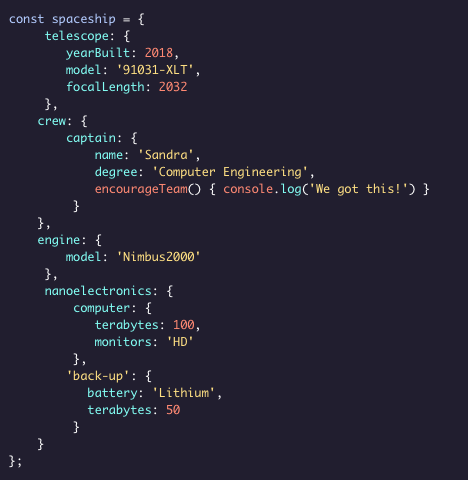
From here accessing these elements works using a string of dot and bracket notation.
Example: let capFave = spaceship.crew.captain['favorite foods'][0];
Pass by Reference
Functions can easily assign (or re-assign) object properties due to their ability to link to where those objects are stored. Alternatively, functions cannot modify the variable holding the object, as this in the global scope. If an object is set equal to a value in a function, that generally creates an equal variable within the scope of the function, and doesn't impact the global variable.
Advanced Objects Concepts
The this keyword
When running methods inside of an object, the method doesnt automatically have access to the properties on its parent objects (they arent in the same scope.). This is where the keyword this comes into use. It is used like this:
let obj = {
test : 'value',
print() {
return console.log(`This has been a great ${this.value}.`)
}
}
This presents a problem when using an arrow function. Arrow functions automatically bind the this keyword to themselves, and thus a this placed inside will failed to reference the parent object's properties. Avoid using arrow functions when this is needed in code.
Privacy in Objects
Javascript lacks a native way to label data as requiring privacy. In practice, developers in Javascript will usually name properties that shouldn't be changed to begin with an _.
Example: _name = 'Matthew Okoorian'.
Despite this practice, these values can still be replaced in practice. However with the application of getter and setter functions, these _ can be respected as intended.
Getters and Setters
- Getters - Methods that get and return the properties of an object. However, they are more than this in several ways.
- they can perform an action on the data prior to returning it
- they can return different values based on conditionals
- easier code functionality to understand
- We can access properties of the calling object using the this keyword.
- Setters - methods that reassign the values of existing properties on an object.
- able to check what value is being assigned
- can perform actions on the data submitted
- can return helper text based on condition if wrong value is submitted.
Getters are set within an object using the following syntax:
get method() {....
}
Setters are set within an object using the following syntax:
set method(){...
}
NOTE: When calling these methods, don't use () after the name of the method.
Factory Functions
Factory functions are functions that take a few parameter values and return an object with those parameters set as object properties. Here is an example of what a factory function should look like:
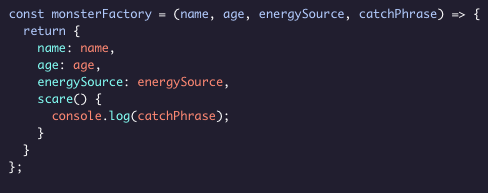
With these factory functions defined, they can be used by call inside of a variable setting as so:

Destructing Shorthand for a Factory Function
The Factory function can be further shorthanded using the following syntax:
const factoryFunction = ('a', 'b', 'c') => { or this will return an equivalent result:
return {
val1: 'a',
val2: 'b',
val3: 'c'
}
}
const factoryFunction = ('a', 'b', 'c') => {
return {
'a',
'b',
'c'
}
}
Destructured Variable Assignment
Say you want to assign a variable to an object property. This would typically be done like this.
const myName = me.name
With destructured assignments, the property can be assigned to a variable of a matching name using this syntax:
let {name] = me
or let {name} = me.names
if the property is on an object within an object.
Built in Object Methods
- .hasOwnProperty() or .hasOwn() - returns true if object has the property provided as a method parameter.
- .valueOf() - returns the primitive value of the object. If there is no primitive value, it returns itself.
- .assign(target, source) - takes a target and a source object input. Adds or overwrites all properties from the source into the target.
- .entries() - returns an array of the object's key : value pairs back.
- .keys() - returns an array of the object's keys. This can also be used on arrays.
Array Example (use the keyword Object):
Object.keys(arr)
Conditionals
Conditionals are used for making decisions in coding. They consider a condition, and perform an action based on defined criteria.
The basic structure of an if Javascript statement goes as follows:
if (condition) {
console.log(aResult)
};
- if is the keyword that begins the conditional
- condition evaluates to true or false. If it is true, the resulting code will execute. If false, the block won't execute.
Alternatively, following the closing }, an else statement can be added which will run if the condition is false.
Example: ...preceding action} else {
console.log('The first condition failed')
}
Comparison Operators
Conditions commonly compare two values to determine a true or false outcome. The following operators enable those comparisons.
- < - less than. Place between two numbers to compare and confirm whether the left if lower than the right (true).
- > - greater than. Place between two numbers to compare and determine whether the left is greater than the right (true).
- <= - less than or equal to. Same as less than but also returns true when values are equal.
- >= - greater than or equal to. Same as greater than but also returns true when values are equal.
- === - is equal to. Tests whether two numbers are equivalent when placed between them as a condition.
- !== - is not equal to. Tests whether two numbers are not equivalent when placed between them as a condition.
Logical Operators
Logical Operators within conditionals allow one to split or join conditions using And, Or joins or to use Not.
| Logic | AND | OR | NOT |
|---|---|---|---|
| Syntax | && | || | ! |
Example: ('test' === 'test' && 'butter !== 'jelly) resolves to true
Truthy and Falsy Values
When a non-Boolean value is passed into a condition, JavaScript has rules for how to evaluate it. It's easier to note the Falsy values.
- Falsy values
- 0 (for numbers)
- '' or ' ' (empty strings)
- null
- undefined
- NaN - or not a number
Example - can use this principle to default a variable to a value.

Example - can use this in a variable declaration with an OR(||) syntax to declare a backup value if one is Falsy.
An example of assigning a variable with a conditional
Ternary Operators
A conditional can be shorthanded using the following notation:
(condition) ? console.log(action1) : console.log(action2)
Using this shorthand, if the condition evaluates to true, the first action triggers. If false, the second will trigger.
Else if Statements
A series of If statements can be combined in a single conditional using Else if...
Example: If (condition) {
console.log(outcome1)
} else if (condition2) {
console.log(outcome2)
} else {
console.log(outcome3)
}

Switch keyword
Finally for conditionals, the Switch keyword can be used to return different actions when a variable is equal to different values.
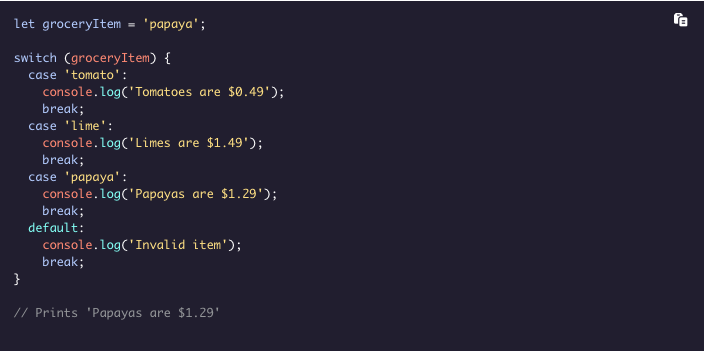
Loops
Loops are used in code to perform the same code multiple times until a condition has been satisfied. A good example of this requirement would be doing the same action to every item inside of an array. This could result in usually needing a seperate line of code for every item of the array. This is better done using the for keyword.
Example: for (let counter = 0; counter < 4; counter ++) {
console.log(counter);
}
Within the (), the first item initializes a state, the second provides the condition to continue, the third indicates a change to make each time the enclosed code runs.
This code can be very easily reversed to count down as well:
for (let counter = 3; counter >= 0; counter--){
console.log(counter);
}
Coders should be cautious when implementing loops to avoid infinite loops (where the termination condition is never reached). To quit out of this, it may be necessary to hit Ctrl-C to quit in a terminal.
Looping through an array
Looping through arrays is as simple as applying the code above while setting condition variables to compare the iterator to the .length of the array.
Nested Loops
Nested loops can be helpful for comparing values within two arrays. In this way, the loop works through one array, and for each item in it, runs a comparison to all of the items in the other array. See the example below:
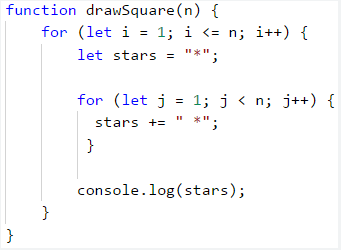
While and Do while loops
Where the loop variable exist within the body of the code, a while loop can be used instead. These are set with the keyword while paired with a condition that modified within the body of the code.
It will continue to run while the condition evaluates to true.
Example:
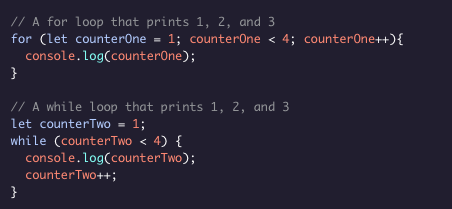
A while loop may never run if its condition never occurs in the first place. This can be overcome if needed with a Do while loop. This uses the keyword do, followed by the action in {}, followed by the keyword while and then the condition in ().
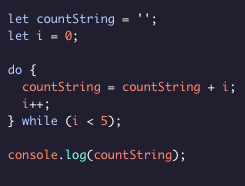
The Break and Continue keywords
Inserting the keyword break into a loop will immediately cause it to end. This can be useful when combined with a conditional within a for loop to check a condition, and end the loop when the condition has been satisfied.
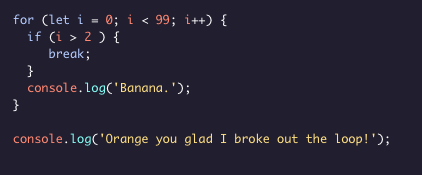
The continue keyword will alternatively prevent code downstream from it from running, and will begin the loop again from the top. This can be used to skip a value if a condition is satisified during the running of the loop.
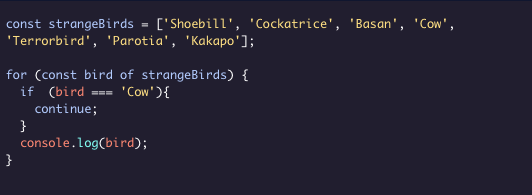
Final Shortcut - The for ..of loop (shown in the Continue example above)
A final approach to for loops occurs to shorthand a for loop that has been applied to all objects within an array. Here values within an array can be set equal to a variable and each fed
into a for loop using an of keyword.
Example:
for (const var of array) {
console.log(`I love this ${var}.`);
}
Looping through objects
Objects in arrays can be looped through using the For and In keywords. They work like this:
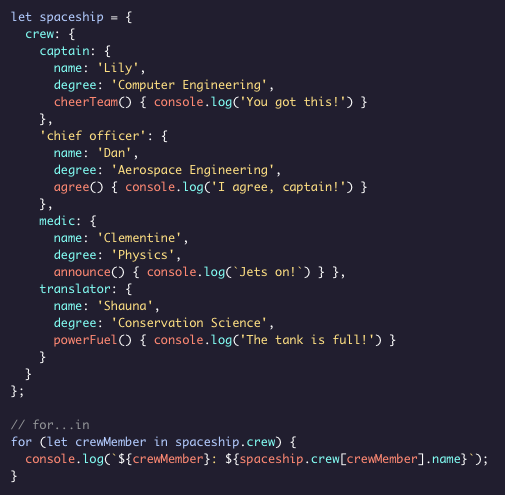
It should be noted that this always primarily returns the keys. They can be entered in dot or bracket notation to access their values.
Functions
Functions serve to establish re-usable blocks of code that can be deployed repeatedly in our code. They are first class objects in Javascript, and can have properties and methods.
Declaring a function
A function can be declared using the function declaration. This looks like:
function greetWorld() {
console.log('Hello World');
}
Here function serves as a keyword. greetWorld() acts as the identifier for the function (the function itself is actually just the name with no ()), and it is how it gets called later on. Inside of the {} is the function body, or what gets executed when the function is called.
Note: Javascript will allow a function to be called in code before it is declared (called Hoisting). This is not considered to be a good coding practice however.
After a function is declared, it can be called by inserting the name of the function into the code followed by (). Example: greetWorld();
Using Parameters and Arguments
A function can be declared using parameters to enable it to receive variables when it gets called. This looks like the following:
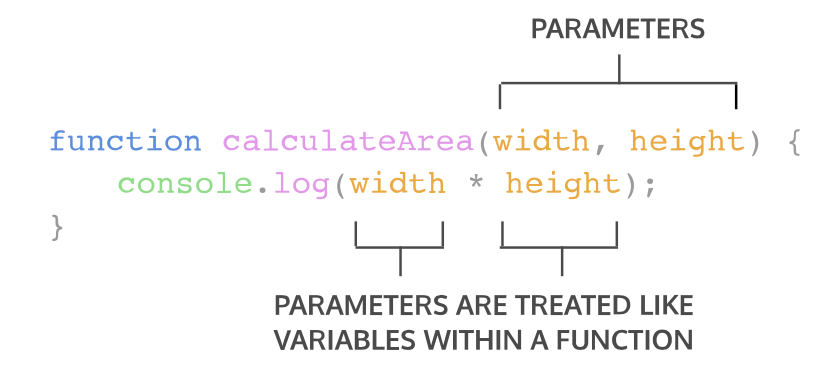
This process enables the use of unique values, or even variables established previously in the code.
Assigning a deault parameter
A default parameter can be set on a function to use in the event that no value is passed in. This looks like this:
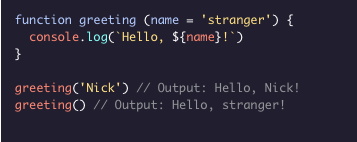
Determine what to return with a function
When a function runs, it follows its instructions and returns a result. In the examples above, the function prints text to the console.
However, it is also returning a value. If undefined, the function returns the value "Undefined".
Example: first declare function typeA() {
console.log('A');
}. if console.log(typeA()) is run, it will retun Undefined, as it prints when run, but when inserted in a print statement, it returns nothing.
Thus, telling a function what to return is as simple as this:

Additional Function Concepts
- Helper Functions - functions inside of other functions that perform subtasks of the function.
- Function Expressions - functions can also be declared using variables in a manner called function expressions. This usually uses the const var keyword,
and the const name effectively replaces the function name in the declaration block.
Example: - In this way, these functions can be called as "calculateArea(5, 8)" similar to a normal function definition.
- Anonymous Functions - this label is used when a function is declared within a variable without the function having its own name. The variable name replaces the function name effectively.
Example: const name = function(a,b) { - Arrow Functions - another shorthand for establishing functions. Using function expressions, arrow functions look like this:
- This can be shortened even further with the arrow pointing directly to a return.
Example:
const test = num => num*num . num here is a parameter, and num*num returns when this test(*) is called. test(5) = 25
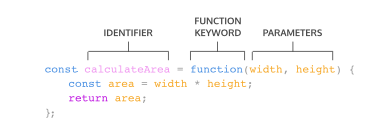
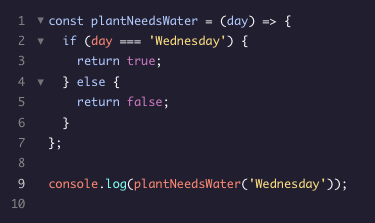
Coding Concepts
Abstraction
When we code, it is often necessary to simplify tasks for reuse. In this way, a complex multi-stage process can be broken down to subtasks. Subtasks can sometimes be constructed as functions that serve as parameters for other functions. Functions can return functions, and ultimately this nesting can become quite complex while also clarifying the purpose of specific code in a program.
The simplest form of this is to set functions equal to other functions. This may enable use of a function with a clearer name in the context in which it is being used.
Because functions have names, running console.log(function.name) can help identify the original function within the script.
High-Order Functions
High-order functions are those that take or return other functions. In this way these functions can provide flexibility around up and downstream use of functions. See the image below for an example.
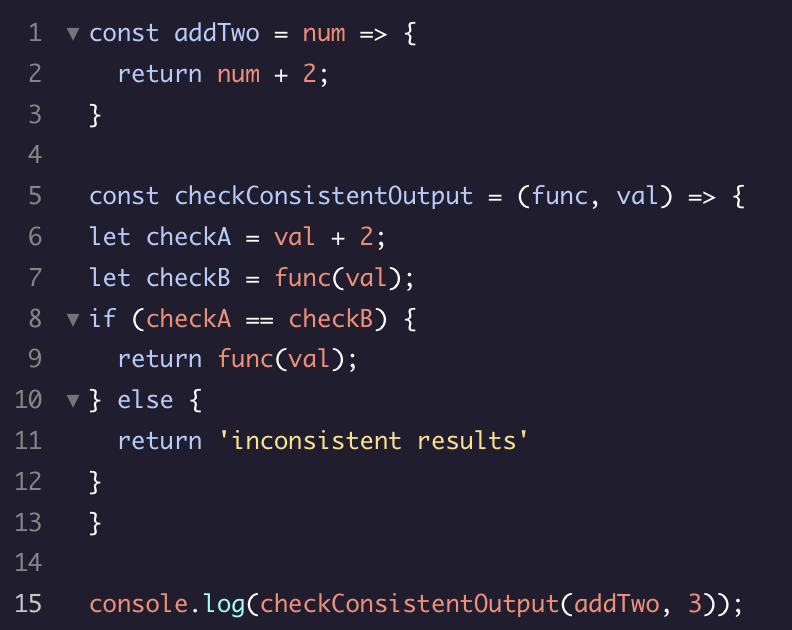
Iterators
Connecting JavaScript to HTML
To connect JavaScript and have it start to interact with HTML, there are two options:
- Add a pair of <script> tags as the very last enclosures within the <body> tags of an HTML file. Add all JavaScipt code inside of these tags.
- Alternatively, link an external JS file using a script tag in the head of the document.
Example:<script src="./exampleScript.js"></script>
If multiple scripts are related to an HTML file, they will run in sequential order.
Attributes that can be associated to Script elements
Defer - specifies that script should be executed after the HTML file is completely parsed. When encountered, the page will load the script but not execute it until all HTML is rendered. To assign this attribute, place defer inside the opening script tag.
example: <script id="blue" src="turnBlue.js" defer></script>
Async - specifies that the script should execute as soon as it is loaded to the page. This is suggested if it optimizes page load time. It is best when the script doesn't interact with the DOM so isnt reliant on specific HTML content having loaded to the page.
Understanding the DOM (Document Object Model)
When browsers render HTML text, they also generate the display according to what is called the DOM. The DOM is an scripting object model which defines everything that you see on the page. Page contents are organized in a tree in the same manner that elements are nested in an HTML script. This organization is modeled by the diagram shown below.
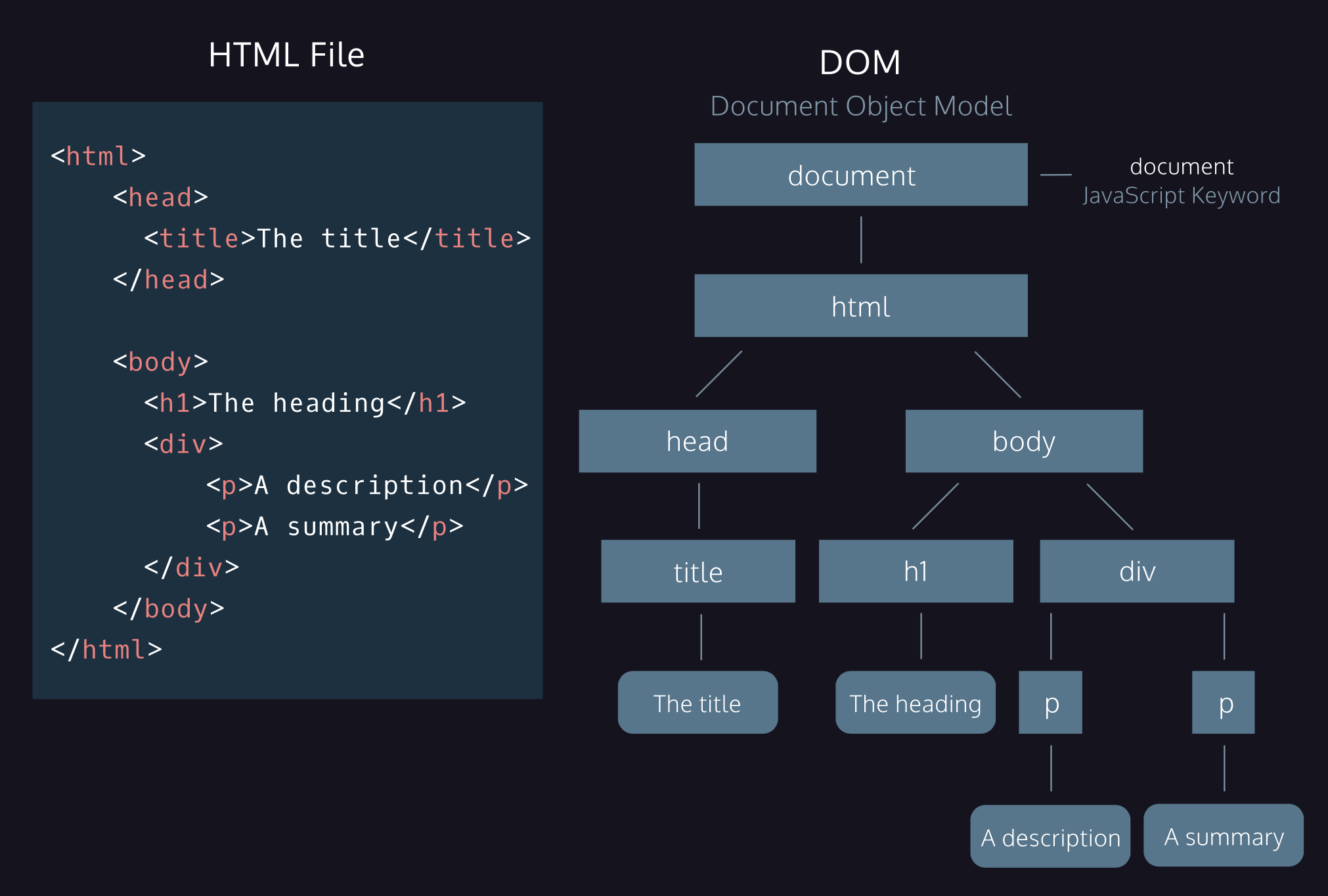
This tree structure starts at the Document and descends as...
- Document
- html
- head
- title
- this is the title value inside the title tag.
Notice within the diagram above that elements are modeled using square corner boxes, and that text values are modeled using rounded corner boxes. The DOM can enable interactions with both of these levels. Additionally, the DOM can enable access to an element's attributes like its class, id, or its style and the contained attributes.
Selecting and tweaking elements.
Elements on the page can be modified by selecting and setting them equal to new values. There are several ways to accomplish this.
docuemnt.body.innerHTML = "<p>Hello World<p>"document.querySelector('p')document.getElementByID('id').innerHTMLdocument.getElementByClassName('header').innerHTMLdocument.getElementbyID('id).style.color = 'red'.childrenand.parentNodepropertieslet placeholder = document.createElement('p')document.selectedelement.appendChild(placeholder).removeChild(element)and.hidden = true
This will select the body portion of an HTML DOM and replace it entirely with what is placed after the = sign. This is a bit of a shotgun approach to modifying the DOM however.
enables the selection of the first instance of the provided CSS selector provided.
enables the selection of elements by their ID property.
searches for elements on the page that have the provided class. Will return an array of those items. A user can then access specific elements by ending it with a [] including the index number of the element desired.
Example: document.getElementByClassName('header')[2].innerHTML
Use the .style.property set of tags to select and set a style property of an element to a specific value.
These properties return an array of the "children" objects under the element they are run on or the specific parent object of the element respectively. If .parentNode is performed on the document element, it will return null as the document element in the top level of the DOM.
allows for the creation of a new element. This element won't automatically be placed into the DOM until you pair this function with...
the appendChild function allows for the insertion of a new element as the last child of selected element.
Example: appendChild to a <ul> tag of a <li> will add it within the ul as the last li.
removeChild follows from a selected element and removes an element under it. The element to remove needs to be specified. Another way to acheive this without really removing the element is to hide elements. This can be done by setting a selected element's hidden property to "true".
DOM Events
Code can be added to have code trigger to run based on specific events that occur in the DOM (click on element, etc.).
Examples of events (called firing events) include:
- clicking on an element.
- loading a page.
- user swiping right on an image.
Code for establishing listeners
- element.addEventListener('click', function {
//code to rune when event occurs
}) - element.removeEventListener('click', eventHandlerFunction)
element.onclick = function
This code removes an event listener that was previously established. The function name must be the same as the one used to establish the listener. This method can be called inside of a triggering function to prevent that function from being triggered multiple times.
Setting .onclick equal to a function will result in the function running when that element is clicked.
Example: document.body.onclick = function() {
document.body.style.color = 'blue'
}
Note: onclick is an example of an event type listener. Other events can formated in this manner with on... using a lower case form of the event.
Using onclick., users can set elements style.display = 'none' to hide and reveal elements by setting them back to 'block'. A lot of cool functionality can be introduced in this manner.
Event Object Properties
Events are objects within the DOM model. As such, they have a few properties that can be called that are useful for interaction.
- event.target
- event.type
- event.timestamp
This property returns the element that triggered the event. This is useful when a listener is applied to multiple elements, and the code needs to know which one was clicked.
This property returns the type of event that was triggered. This is useful when a listener is applied to multiple event types.
This property returns the time at which the event was triggered in milliseconds from the loading of the page. This is useful for logging events.
Functions can be written using events as inputs. This allows that function to reference details of the event (such as its target, type, etc.) when it runs.
Example: element.addEventListener('click', function(event))
function(event) {
event.target.style.display = 'none';
}
Other Events
- wheel - triggers when rolling a mouse scroll wheel. Also triggers on trackpads.
